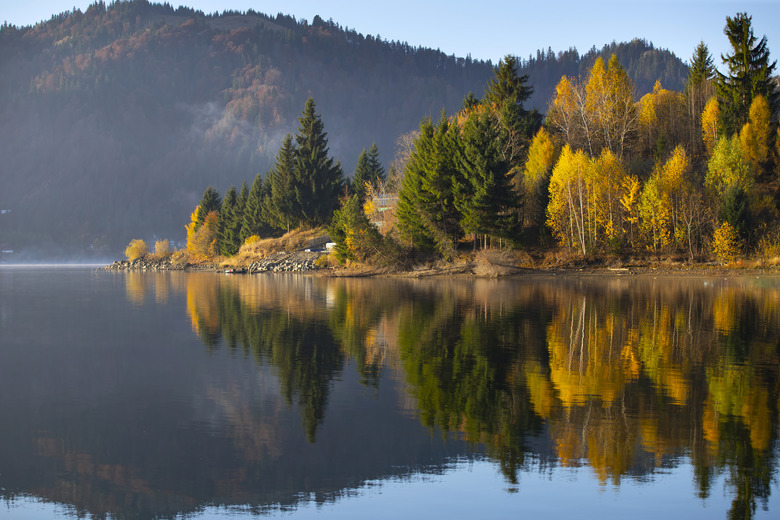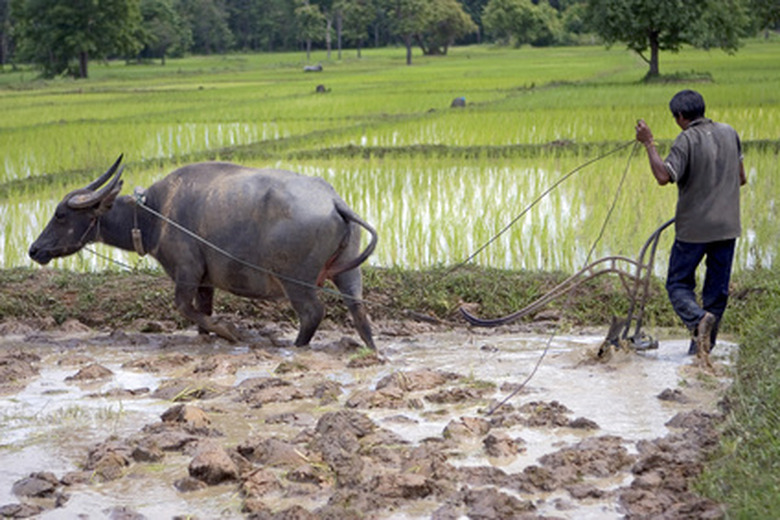Landforms In Freshwater Areas
Flowing freshwater from rivers, creeks, brooks and streams cause erosion that shapes the topography of Earth's surface. This movement of water deposits sediments to create landforms, such as floodplains, alluvial fans and deltas. The erosion of rocks and soil also create landforms such as channels, canyons and valleys. Where water settles, lakes and ponds are formed as well as marshes and other forms of wetlands.
Deltas and Estuaries
Deltas and Estuaries
When a stream or river enters a lake, its speed slows and silt and sand are deposited to form a delta. This sediment can form a triangular shape much like the Greek letter "delta." These deltas are often the extension of a nearby floodplain, and where flood controls or drainage takes place the area can provide fertile agricultural land. Estuaries are considered the counterparts of deltas and occur where freshwater meets saltwater, such as the mouth of the St. Lawrence River. It is estimated that streams and rivers deposit 1.5 billion tons of sediment into the oceans each year.
Lakes and Ponds
Lakes and Ponds
Lakes and ponds are bodies of water surrounded by land on all sides. Lakes are usually too deep to support any rooted plants, except near the shoreline. Some lakes are big enough to produce waves and since light does not penetrate readily, photosynthesis is found only in the top layer. A pond is a smaller body of water surrounded by land and is shallow enough to support rooted plants, which can entirely cover a shallow pond. Unlike lakes, even large ponds have very little wave action and the bottom is usually covered with mud.
Wetlands
Wetlands
There are many types of waterlogged landscapes known as wetlands, including swamps, bogs and marshes. Some wetlands are even man-made, such as rice paddies and those formed around reservoirs. A marsh is a type of wetland found around rivers, ponds and lakes. They usually contain plants which grow up and out of the water. A swamp is a type of freshwater wetland that has a spongy, muddy surface and usually has a greater water content than a marsh. Most swamps can support a variety of larger trees and shrubs.
River Landforms
River Landforms
Rivers are important for transporting and depositing sediments, a product of erosion. A river cuts both downwards and sideways to shape and form wide valleys and deep canyons. The faster the river current's velocity and the courser the sediment it carries, the deeper and wider the valley or canyon becomes. A waterfall may also develop where a stream or river flows over the edge of a plateau or cliff in mountainous terrain. As water continues to fall onto the valley floor, it erodes the land at the base of the waterfall to create a basin.
Cite This Article
MLA
Barber, David. "Landforms In Freshwater Areas" sciencing.com, https://www.sciencing.com/list-7644650-landforms-freshwater-areas/. 22 November 2019.
APA
Barber, David. (2019, November 22). Landforms In Freshwater Areas. sciencing.com. Retrieved from https://www.sciencing.com/list-7644650-landforms-freshwater-areas/
Chicago
Barber, David. Landforms In Freshwater Areas last modified August 30, 2022. https://www.sciencing.com/list-7644650-landforms-freshwater-areas/

